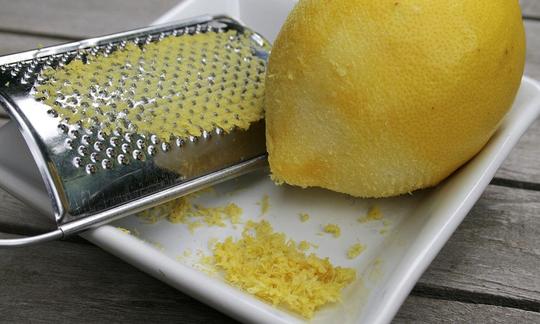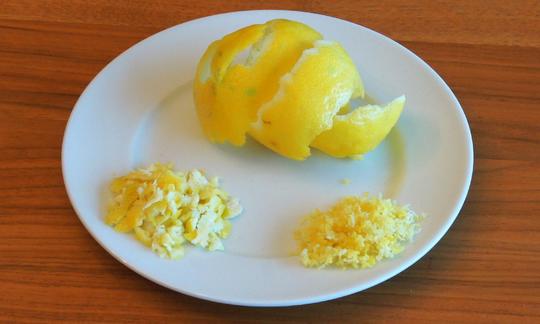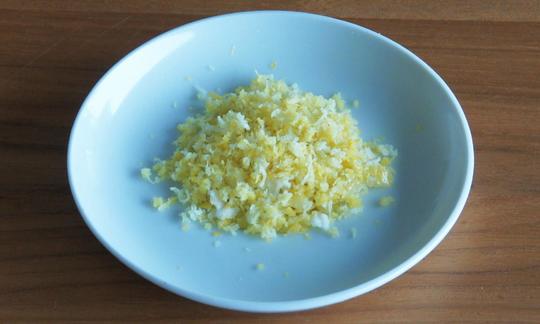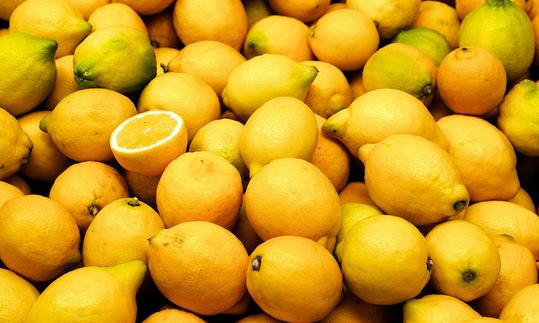Table of contents
Organic lemon peel is ideal for flavouring dishes, baked goods and drinks. The peel also refines sauces and desserts when eaten raw .
Use in the kitchen
Can you eat lemon peel? The peel of untreated organic lemons ( Citrus limon ) is edible and can be used as a flavoring ingredient in the kitchen due to the essential oils found in the oil glands of the peel. 1 Raw lemon peel has a sour, fresh taste and can sometimes taste slightly bitter.
When using the peel of citrus fruits, it is important to ensure that the citrus fruits are untreated, i.e. organic, as conventional citrus plants are treated with harmful, chemical-synthetic pesticides and coatings. Despite organic quality, we still recommend washing organic lemons and rubbing them dry before processing.
The peel of citrus fruits is divided into two components: epicarp (flavedo) and mesocarp (albedo). The epicarp is the colored surface, while the mesocarp is the white, soft middle layer. 2 When grated lemon peels are peeled with a zester or vegetable peeler, only the colored skin layer, i.e. the epicarp, is used, as the white mesocarp usually tastes bitter. However, there are lemon varieties whose albedo is not bitter, such as the Amalfi variety. Just try it out by tasting. Thick white peels in particular can be cut into thin slices and then marinated with a little salt and rapeseed oil, leftover lemon flesh and lemon juice .
How can you eat lemon peel? If you like, you can eat washed organic lemon peel raw. However, it is often used to flavor and refine all kinds of vegan dishes, whether sweet or salty, baked goods and drinks. Lemon peel gives risotto (e.g. risotto with green asparagus and macadamia ), soups, sauces and desserts (e.g. apricot cream cake ) a deliciously fruity note and is popular as a garnish. Freshly grated lemon peel also gives breakfast muesli a refreshing taste. Why not try it with pea muesli (also with oat flakes ). Also recommended are the energy bars with berries, ginger and nuts enhanced with lemon peel.
Drinks can also benefit from the refreshing fruitiness of lemon peel. To make lemonade, chop a washed organic lemon with the peel in a blender, mix everything well, remove the seeds and add water . If you like, you can sweeten it with a little sugar, agave syrup or other sweeteners. Lemon tea or lemon peel tea, which can be enjoyed hot or cold, is also popular. To make it, use pieces of peel from two lemons in one litre of water, boil it briefly and let it steep for 15 minutes. Then pour in the lemon juice and add a little sweetener to taste.
Lemon peel can also be preserved by adding salt, sugar or oil, which also produces foods that taste like lemon. Another example of preserving lemon peel is candying. This produces candied lemon peel, known as candied lemon peel or candied sugar. Peel peeled with a vegetable peeler can also be dried in the air or in the oven, ideally at raw food temperatures (below 42 °C), or dehydrated at the lowest temperature. Dried lemon zest is available commercially. Due to its aromatic smell and attractive color, it is used primarily in the bakery and confectionery industries. 3 Dried lemon peel can also be found in homemade tea blends, herbal teas or fruit teas.
Possible uses and recipe ideas for lemons (without peel) and lemon juice can be found in the corresponding article.
Homemade preparation
Here we describe different ways of obtaining lemon peel and in the following chapters we give some simple lemon peel recipes in brief.
Finely grated lemon peel: You can grate the lemon peel off washed organic lemons using a fine kitchen grater, lemon rasp or grater. This produces particularly fine pieces. If you place baking paper or bread paper between the grater and the fruit, the grater will remain free of stuck pieces. You simply hold the paper together with the grater. This only really works on the second or third grating process, because the teeth have to push through the paper first.
Lemon zest: Lemon zest is the product that you get with a zester, i.e. very thin strips from the colored part of the lemon peel (flavedo). This small kitchen tool consists of a blade with sharp-edged holes. You can also use a paring knife to peel thin strips of peel, which you can then cut into even finer strips on a cutting board with a knife.
Coarse lemon peel pieces: For dishes where you remove lemon peel after cooking or use it for decoration, you want larger strips, which you can achieve with a vegetable peeler. Here, too, you peel so thinly that the white part of the lemon peel (albedo) is not included.
Freezing lemon peel: Lemon slices with peel, lemon zest or even lemon zest can be easily frozen, e.g. in freezer bags or in an ice cube tray.
Recipe for salted lemon peels
First, weigh the peels of organic lemons that you have removed with a vegetable peeler. Then add a third of this weight in lemon juice and layer the mixture in a glass. In between, sprinkle 12% salt in relation to the weight of the mixture. Then fill with water until all the ingredients are covered with liquid. Store the mixture in the refrigerator, turning it over every day or two so that the brine is evenly distributed. After a few days (at the latest after a week), the peels will have absorbed enough salt. Then let the lemon peel dry. The salty peels will last for years when dried and are suitable, for example, for flavoring braised dishes.
Recipe for lemon peel pepper
How can you make lemon pepper yourself? To make lemon pepper, you need grated or peeled, dried lemon peel. To achieve raw food quality, dry the peel at a maximum of 42 °C for three hours. Air-drying takes a few days, but this ensures that most of the vitamins are retained. The pieces are dry when they break easily. After cooling, crush the peel, crushedpeppercorns and sea salt together in a mortar or blender. The mixing ratio is as follows: lemon peel from two to four organic lemons to 50 g pepper and 10 g sea salt. Depending on your taste, you can use more, less or no salt and of course adjust the ratio of pepper to peel.
Storing it in an airtight spice jar or spice shaker in a cool, dry place protected from light has proven to be effective. This way, you can enjoy your homemade lemon pepper for up to six months. Lemon pepper is suitable for seasoning at the table or just before a dish is finished. Lemon pepper can also be enhanced in taste by adding garlic powder, paprika powder and/or herbs such as dried thyme .
Recipe for lemon-flavoured sugar
Lemon-flavoured sugar is very easy to make yourself: To do this, dry grated lemon peel in the air for a day and put it in a sealable jar into which you have first sprinkled sugar. Then add another layer of sugar and shake the whole thing. Repeat this shaking process every two days and after about two weeks you will have well-flavoured lemon sugar.
Recipe for lemon extract
A natural lemon extract is made by putting pieces of the colored peel into a container with almost tasteless vodka. The mixture should be left to steep for at least two weeks, but six weeks or more is better. For example, you can use a preserving jar that you close and put in a cool, dark place, but not in the refrigerator. Always make sure that the peel is covered with vodka, otherwise it can go moldy. For each organic lemon, you need 125 ml of vodka. The extract can be used to refine drinks or dishes that can contain alcohol, such as punch.
Vegan recipe for lemon jam
For lemon jam, you use 7 organic lemons, 1 kg vegan gelling sugar and 300 ml water. Remove only the colored peel (flavedo) without the white layer (albedo), cut into strips and bring to the boil with the water. Simmer gently for 60-90 minutes with the lid closed. Squeeze the juice from the peeled lemons and set aside. Cut the rest of the lemons, including the albedo and seeds, into small pieces and simmer gently in another pot covered with water for two hours. Then squeeze out the fruit residue with a spoon over a sieve and collect only the liquid.
Now pour all three parts together, i.e. the peels and their cooking liquid, the juice from the lemon residue and the lemon juice. Add one kilogram of vegan gelling sugar per resulting liter. Bring to the boil and let it simmer for four minutes while stirring. Pour the mixture into sterilized preserving jars while it is still hot. Turn the screw-top jars upside down for about ten minutes so that the still hot fruit pulp also sterilizes the inner, upper rim. This does not apply to Weck preserving jars. Allow to cool and store in a dark, cool place. Sealed jars will keep for several months; opened jars should be kept in the refrigerator.
Vegan recipes with lemon peel (raw) can be found under the note: " Recipes that have the most of this ingredient ".
| Not only vegans or vegetarians should read this: Vegans often eat unhealthily. Avoidable nutritional errors . |
Purchasing - Storage
Dried, grated lemon peel is available at some supermarkets (e.g. Coop, Migros, Spar, Rewe, Edeka, Billa ). Other supermarkets (e.g. Denner, Volg, Aldi, Lidl, Hofer ) only occasionally stock dried lemon peel during special weeks. Organic supermarkets such as Denn's Biomarkt and Alnatura sell the dried peel in organic quality. 5 g of dried lemon peel is roughly equivalent to the grated peel of one lemon.
Conventional dried lemon peels often contain additives such as sugar, water and natural flavouring, as well as acidifiers (citric acid / citric acid E330), preservatives (potassium sorbate E202 and sodium metabisulfite E223) and colourings (beta-carotene E160a). Organic products usually only contain lemon oil in addition to dried lemon peel.
It is often not clear from the packaging whether the lemon peel has been gently dried at temperatures of max. 42 °C and is therefore considered raw food, or whether the production process involved high heating. If you want to be on the safe side, buy organic lemons, grate the raw peel yourself and use it directly or dry the peel at low temperatures suitable for raw food (in the oven at max. 42 °C or in the air).
The availability of lemon peel (raw) varies depending on the size of the store, catchment area, etc. Our recorded food prices for the DA-CH countries can be found above under the ingredient image - and by clicking on them you can see their development at various suppliers.
Storage tips
Fresh lemon peel is best used immediately or dried for storage. Dried lemon peel can be kept for several months in an airtight container in a cool, dark place. It can also be preserved with salt or sugar (see lemon peel recipes at the beginning of the article).
Lemons and lemon peel should not come into contact with aluminum foil, as the acid dissolves aluminum and the light metal is suspected of causing harmful effects on health.
Ingredients - Nutritional values - Calories
The energy content of lemon peel (raw) is 47 kcal/100g. The protein content is rather low at 1.5 g/100g. Fat is hardly present at all at 0.3 g/100g. It contains 16 g/100 g carbohydrates, of which 4.2 g is sugar. Thefiber content is 11 g/100 g. 4 The following are three notable lemon peel ingredients (nutrients).
With 129 mg/100g (161% of the daily requirement), lemon peels are particularly rich in vitamin C (ascorbic acid) . Orange peels contain a similar amount at 136 mg/100g. Lemons without peel (53 mg/100g) and lemon juice (39 mg/100g) contain significantly less of the vitamin. Even more vitamin C can be found in yellow bell peppers (184 mg/100g). 4
Raw lemon peel contains 134 mg of calcium per 100 g (17% of the daily requirement). A similar amount can be found in orange peel (161 mg/100g), much less in lemons without peel (26 mg/100g) and lemon juice (6 mg/100g). Fennel seeds contain significantly more at 1196 mg/100g. 4
Lemon peel (raw) also contains 0.17 mg of vitamin B6 (pyridoxine) per 100 g (12% of the daily requirement). Orange peel has a comparable content (0.18 mg/100g). Lemons without peel (0.08 mg/100g) and lemon juice (0.05 mg/100g) are also inferior to lemon peel in terms of pyridoxine content. Raw pistachios contain a lot of vitamin B6 at 1.7 mg/100g. 4
Some of the secondary plant substances found in lemon peel are essential oil (consisting of citric acid, terpineol, pinene, limonene and citral, among others), phenolic acids (ferulic acid, caffeic acid, sinapic acid) and flavonoids (flavones, flavonols, flavanones such as hesperidin, hesperetin and neohesperidin). 1,5, 6,7
The complete ingredients of lemon peel (raw), the coverage of the daily requirement and comparison values with other ingredients can be found in our nutrient tables. In the article Nutrients explained you will get a detailed insight into the topic.
Health effects
Is lemon peel healthy? The peel of citrus fruits is a good source of phenolic acids. The content of phenolic acids (such as ferulic acid and caffeic acid) is significantly higher in citrus peel than in lemons without peel . Flavonoids (such as flavones, flavonols, flavanones, including hesperidin, hesperetin and neohesperidin), which have anti-inflammatory and antioxidant activities, have also been identified in lemon peel. 6,7,8 Flavonoids also have anti-cancer effects and may be useful in the prevention of infectious and degenerative diseases. 8 The flavanone hesperidin, which is present in larger quantities in the peel (flavedo and albedo) than in hand-pressed juice, is associated with anti-inflammatory, antioxidant and anti-carcinogenic effects as well as antibacterial and antimicrobial properties. 9
Apart from phenolic compounds and flavonoids, citrus peel is also rich in other health-promoting substances such as essential oils and pectin. 6,8 Pectins are plant polysaccharides and are indigestible dietary fibers for humans. They can lower lipid and cholesterol levels as well as blood sugar and insulin levels, delay gastric emptying (eg in cases of diarrhea) and help fight cancer. 6,10 Pectin ingested with food can also bind metal ions, especially lead ions, thereby reducing their retention in the body and weakening their toxic effects (eg in cases of heavy metal poisoning). 10
Lemon peel extract helps prevent and treat calcifications in the urinary tract by inhibiting the formation of calcium oxalate stones and protecting the urinary tract from stone-related damage. 6 The extract also protects against oxidative cell damage. 11
Lemon consumption is also associated with strengthening the immune system and reducing the harmful effects of cardiovascular disease. 11
You can find out more about the health benefits of lemons and lemon juice in the related articles.
Dangers - Intolerances - Side effects
If you are allergic to lemons, you should also avoid lemon peel. One possible effect is oral allergy syndrome, which manifests itself in discomfort and itching in the mouth and throat area. Skin reactions can take up to two days to appear. Incidentally, preservatives contained in lemons can also trigger such an allergy. 12
Citric acid attacks tooth enamel. After eating or drinking acidic foods, you should not brush your teeth (with too much pressure), as this will cause the upper layers of the teeth to wear down more. Instead, you should rinse your mouth with water. This dilutes the acid and speeds up the replacement of the dissolved minerals. 13
Folk medicine - natural medicine
Is lemon peel used as a remedy? The medicinal use of citrus peel can be traced back to the 10th century. 8 Today it is used in traditional Chinese medicine ( TCM ), for example. 11
Lemon essential oils (lemon oil) are often used in aromatherapy. Aromatherapy based on lavender, lemon and bergamot essential oils has been reported to prevent symptoms of depression (such as lack of neurogenesis, suppressed dendritic growth of immature neurons and low serum BDNF levels in the hippocampus). Lemon oil therefore has an antidepressant effect. 1
Ecological footprint - animal welfare
The ecological footprint of a food depends on various aspects, such as cultivation method (conventional/organic), seasonality, country of origin, transport and, if applicable, packaging. According to the Danish climate database, the CO 2 footprint of raw lemons in 2024 is 0.64 kg CO 2 eq/kg (2021: 0.94 kg CO 2 eq/kg). 14 We found no figures on the CO 2 footprint of lemon peels in particular.
According to a Dutch study (2011), the water footprint of lemons is 642 litres of water per 1 kg of lemons. 15
For detailed explanations of various sustainability indicators (such as ecological footprint, CO2 footprint, water footprint), see our article: What does the ecological footprint mean? .
In conventional agriculture, synthetic pesticides and herbicides are often used to combat unwanted plants and insects. These have been proven to have a negative impact on the environment and affect important pollinators, birds and mammals, among others. The harmful pesticides are also often found in the end product, as is the case with lemons. 16 Accordingly, when buying lemons and lemon peel, you should not only pay attention to the country of origin and the shortest possible transport routes in order to reduce greenhouse gas emissions, but also to buy organic products in order to protect biodiversity and your own health, among other things. The use of such pesticides is prohibited in organic farming .
Worldwide occurrence - cultivation
It is believed that the center of origin (gene center) of edible citrus fruits is in the southeast of the Himalayas in the area of Assam, northern Myanmar and western Yunnan. 17
There are different opinions about the origin of the lemon ( Citrus limon ). One suggestion is that lemons arrived in India relatively late, while others believe that they were mentioned in early Sanskrit texts dating to around 800 BC. Still others have suggested southern China or possibly Upper Burma as the area of origin. 18
The main growing areas for lemons (and limes ) are India, Mexico, China, Argentina and Brazil. In Europe, Spain is the most important, followed by Italy at some distance. 19
Further information
Lemons are the fruit of the lemon tree (Citrus limon ) and belong to the genus Citrus within the rue family (Rutaceae). The species Citrus limon is the result of a cross between citron ( Citrus medica ) and bitter orange ( Citrus aurantium ). 18
Other related species of the genus Citrus are: lime ( C. latifolia and C. aurantiifolia ), orange ( C. sinensis ), tangerine ( C. reticulata ), clementine ( C. clementina ), pomelo ( C. maxima ), pomelo ( C. grandis ) and grapefruit ( C. paradisi ). Orange peel is also used in cooking. Popular citrus fruit juices include lemon juice, orange juice and lime juice .
Whether the citrus plants mentioned are valid species in the botanical sense is controversial. Some are of the opinion that there are only three valid basic species of the genus Citrus, namely citron ( C. medica ), mandarin ( C. reticulata ) and grapefruit ( C. maxima ), and that the rest are introgressive hybridizations of the basic species. Others include Mexican lime ( C. aurantiifolia), Micrantha ( C. micrantha ) and Citrus halmii in the list of basic species in addition to the three species mentioned above. 20
Note: Since most of the plants mentioned are hybrids, i.e. new plants resulting from crossing different species, an "x" is actually required in the botanical name between the genus name and the species name, e.g. Citrus x limon for lemon.
Alternative names
Grated lemon peel is also called lemon zest. Fine strips of lemon peel are called lemon zest.
In English, lemon peel is known as lemon zest or lemon rind, while grated lemon peel is known as grated lemon peel.
Other uses
Neohesperidin is a flavonoid found in citrus fruits that is used as a natural source for the synthesis of neohesperidin dihydrochalcone (NHDC), a low-calorie semi-synthetic sweetener. The sweetening power of NHDC is several times (1500 times according to a 1995 study) greater than that of crystal sugar (sucrose). 7
Lemon oil is a popular ingredient in skin care products due to its antioxidant properties that prevent premature aging of the skin. It has antibacterial properties thanks to its components citric acid, limonene and pinene, making it a suitable ingredient in the formulation of cleansers, body washes (especially for acne-prone skin) and soaps. In addition, lemon essential oil also has astringent properties that effectively close the pores of the skin and prevent clogs from becoming inflamed. 1
Recipe for cleaning products made from lemon peels
How can you use lemon peels outside of the kitchen? You can easily make citrus cleaner from lemon peels (or peels from all citrus fruits) and white household vinegar. Glass containers are used because of the acid. Fill the peels tightly into a glass. Pour vinegar over them until the peels are covered and leave for two to three weeks. The peels absorb the vinegar. Therefore, you should keep adding vinegar so that the peels are covered (otherwise they will start to mold). The vinegar should be dark in color and smell lemony.
You can use the homemade household cleaner undiluted by pouring it through a sieve into empty spray bottles. A dash of washing-up liquid or liquid soap reduces the surface tension so that the cleaner adheres well to smooth surfaces instead of rolling off. Shaking a little helps to mix the liquid. If you want to use the cleaner for longer than two weeks, add two tablespoons of organic spirit.
For silicone joints and rubber seals, you should only use citric acid or baking soda - again dissolved in water and with a little washing-up liquid or liquid soap - not vinegar. This also applies to descaling. Dissolving limescale often takes around 10-15 minutes, but you can also soak the object to be cleaned overnight.
Important to know: Acidic cleaners such as citrus cleaners with citric acid should not be used on marble and other limestone surfaces, as the acid attacks mineral structures.
Bibliography - 20 Sources
| 1. | Agarwal P, Sebghatollahi Z et al. Citrus essential oils in aromatherapy: therapeutic effects and mechanisms. Antioxidants. 2022;11(12):2374. |
| 2. | Wedamulla NE, Fan M, Choi YJ, Kim EK. Citrus peel as a renewable bioresource: Transforming waste to food additives. Journal of Functional Foods. 2022;95:105163. |
| 3. | Lu SY, Chu YL, Sridhar K, Tsai PJ. Effect of ultrasound, high-pressure processing, and enzymatic hydrolysis on carbohydrate hydrolyzing enzymes and antioxidant activity of lemon (Citrus limon) flavedo. LWT. 2021;138:110511. |
| 4. | USDA United States Department of Agriculture. |
| 5. | Denkova-Kostova R, Teneva D et al. Chemical composition, antioxidant and antimicrobial activity of essential oils from tangerine (Citrus reticulata L.), grapefruit (Citrus paradisi L.), lemon (Citrus lemon L.) and cinnamon (Cinnamomum zeylanicum Blume). Z Naturforsch C. 2021;76(5–6):175–185. |
| 6. | Singh B, Singh JP et al. Phenolic composition, antioxidant potential and health benefits of citrus peel. Food Res Int. 2020;132:109114. |
| 7. | Ortiz A de C, Fideles SOM et al. Therapeutic effects of citrus flavonoids neohesperidin, hesperidin and its aglycone, hesperetin on bone health. Biomolecules. 2022;12(5):626. |
| 8. | Koolaji N, Shammugasamy B et al. Citrus peel flavonoids as potential cancer prevention agents. Curr Dev Nutr. 2020;4(5):nzaa025. |
| 9. | Pyrzynska K. Hesperidin: a review on extraction methods, stability and biological activities. Nutrients. 2022;14(12):2387. |
| 10. | Wikiera A, Irla M, Mika M. Health-promoting properties of pectin. Postepy Hig Med Dosw. 2014;68:590–596. |
| 11. | Wang J, Zhai Y, Ou M, Bian Y, Tang C, Zhang W, u. a. Protective effect of lemon peel extract on oxidative stress in h9c2 rat heart cell injury. Drug Des Devel Ther. 2021;15:2047–2058. |
| 12. | Allergiefreie Allergiker de: Zitrusfrüchte Allergie: Symptome und Tipps zu Allergien auf Orangen, Zitronen, Mandarinen. |
| 13. | Wetzel WE. UGB-Forum Spezial: Von klein auf vollwertig. Zahnschäden: Nach der Nuckel- die Rennfahrerflasche? S. 19-20. |
| 14. | Concito. The Big Climata Database. Version 1.1. Lemon. 2024. |
| 15. | Mekonnen MM, Hoekstra AY. The green, blue and grey water footprint of crops and derived crop products. Hydrol. Earth Syst. Sci. 2011;15:1577–1600. |
| 16. | Pergola M, D'Amico M, Celano G, et al. Sustainability evaluation of Sicily’s lemon and orange production: An energy, economic and environmental analysis. Journal of environmental Management. 2013; 674-682. |
| 17. | Wu GA, Terol J, Ibanez V, et al. Genomics of the origin and evolutions of Citrus. Nature. 2018;554:311-316. |
| 18. | Curk F, Ollitrault F et al. Phylogenetic origin of limes and lemons revealed by cytoplasmic and nuclear markers. Ann Bot. 2016;117(4):565-583. |
| 19. | FAOSTAT Crops Lemons and Limes. Production Quantity. 2022. |
| 20. | CABI Digital Library org: Citrus aurantiifolia (lime). 2019. |

















Comments